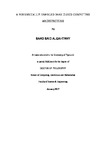A FORENSICALLY-ENABLED IAAS CLOUD COMPUTING ARCHITECTURE
| dc.contributor.supervisor | Clarke, Nathan | |
| dc.contributor.author | Alqahtany, Saad | |
| dc.contributor.other | School of Engineering, Computing and Mathematics | en_US |
| dc.date.accessioned | 2017-06-21T10:17:59Z | |
| dc.date.issued | 2017 | |
| dc.identifier | 10426405 | en_US |
| dc.identifier.uri | http://hdl.handle.net/10026.1/9508 | |
| dc.description.abstract |
Cloud computing has been advancing at an intense pace. It has become one of the most important research topics in computer science and information systems. Cloud computing offers enterprise-scale platforms in a short time frame with little effort. Thus, it delivers significant economic benefits to both commercial and public entities. Despite this, the security and subsequent incident management requirements are major obstacles to adopting the cloud. Current cloud architectures do not support digital forensic investigators, nor comply with today’s digital forensics procedures – largely due to the fundamental dynamic nature of the cloud. When an incident has occurred, an organization-based investigation will seek to provide potential digital evidence while minimising the cost of the investigation. Data acquisition is the first and most important process within digital forensics – to ensure data integrity and admissibility. However, access to data and the control of resources in the cloud is still very much provider-dependent and complicated by the very nature of the multi-tenanted operating environment. Thus, investigators have no option but to rely on the Cloud Service Providers (CSPs) to acquire evidence for them. Due to the cost and time involved in acquiring the forensic image, some cloud providers will not provide evidence beyond 1TB despite a court order served on them. Assuming they would be willing or are required to by law, the evidence collected is still questionable as there is no way to verify the validity of evidence and whether evidence has already been lost. Therefore, dependence on the CSPs is considered one of the most significant challenges when investigators need to acquire evidence in a timely yet forensically sound manner from cloud systems. This thesis proposes a novel architecture to support a forensic acquisition and analysis of IaaS cloud-base systems. The approach, known as Cloud Forensic Acquisition and Analysis System (Cloud FAAS), is based on a cluster analysis of non-volatile memory that achieves forensically reliable images at the same level of integrity as the normal “gold standard” computer forensic acquisition procedures with the additional capability to reconstruct the image at any point in time. Cloud FAAS fundamentally, shifts access of the data back to the data owner rather than relying on a third party. In this manner, organisations are free to undertaken investigations at will requiring no intervention or cooperation from the cloud provider. The novel architecture is validated through a proof-of-concept prototype. A series of experiments are undertaken to illustrate and model how Cloud FAAS is capable of providing a richer and more complete set of admissible evidence than what current CSPs are able to provide. Using Cloud FAAS, investigators have the ability to obtain a forensic image of the system after, just prior to or hours before the incident. Therefore, this approach can not only create images that are forensically sound but also provide access to deleted and more importantly overwritten files – which current computer forensic practices are unable to achieve. This results in an increased level of visibility for the forensic investigator and removes any limitations that data carving and fragmentation may introduce. In addition, an analysis of the economic overhead of operating Cloud FAAS is performed. This shows the level of disk change that occurs is well with acceptable limits and is relatively small in comparison to the total volume of memory available. The results show Cloud FAAS has both a technical and economic basis for solving investigations involving cloud computing. | en_US |
| dc.description.sponsorship | Saudi Government | en_US |
| dc.language.iso | en | |
| dc.publisher | University of Plymouth | |
| dc.subject | Digital Forensics | en_US |
| dc.subject | Cloud Forensics | en_US |
| dc.subject | Digital Investigation | en_US |
| dc.subject.classification | PhD | en_US |
| dc.title | A FORENSICALLY-ENABLED IAAS CLOUD COMPUTING ARCHITECTURE | en_US |
| dc.type | Thesis | |
| plymouth.version | publishable | en_US |
| dc.identifier.doi | http://dx.doi.org/10.24382/800 | |
| dc.rights.embargodate | 2018-06-21T10:17:59Z | |
| dc.rights.embargoperiod | 12 months | en_US |
| dc.type.qualification | Doctorate | en_US |
| rioxxterms.version | NA |
Files in this item
This item appears in the following Collection(s)
-
01 Research Theses Main Collection
Research Theses Main


